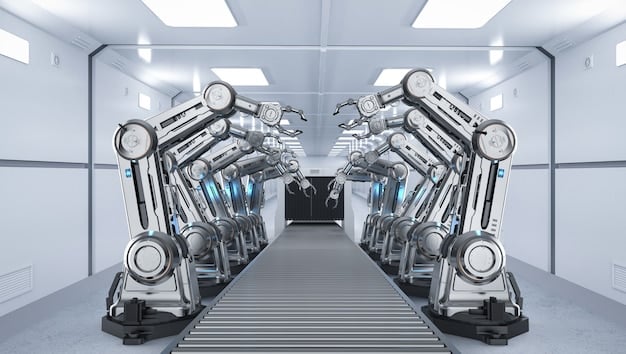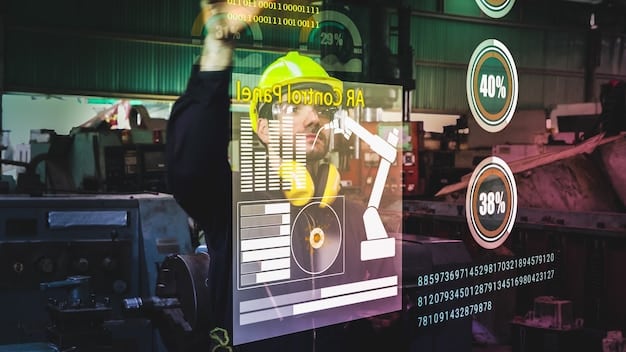Automotive Manufacturing: Latest Tech & Efficiency Boosts

The latest innovations in automotive manufacturing technology, such as AI-driven automation, 3D printing, and advanced robotics, are significantly enhancing production efficiency by reducing costs, improving quality, and accelerating time-to-market.
The automotive industry is undergoing a monumental transformation, driven by groundbreaking technological advancements. Exploring what are the latest innovations in automotive manufacturing technology and their impact on production efficiency reveals a landscape of increased automation, precision, and sustainability that promises to reshape how cars are made.
The Rise of AI and Machine Learning in Automotive Manufacturing
Artificial intelligence (AI) and machine learning (ML) are no longer futuristic concepts; they are integral parts of modern automotive manufacturing. These technologies are optimizing processes, predicting potential issues, and enhancing overall efficiency in ways previously unimaginable.
Predictive Maintenance
One of the most impactful applications of AI is in predictive maintenance. By analyzing data from sensors embedded in manufacturing equipment, AI algorithms can predict when a breakdown is likely to occur. This allows manufacturers to schedule maintenance proactively, minimizing downtime and preventing costly repairs.
Quality Control
AI is also revolutionizing quality control. Traditional methods relied on manual inspections, which were often subjective and prone to human error. AI-powered vision systems can now inspect components with far greater accuracy and consistency, identifying even the smallest defects that might be missed by human inspectors.
- Enhanced Accuracy: AI vision systems can detect defects with greater precision.
- Reduced Downtime: Predictive maintenance minimizes unexpected equipment failures.
- Increased Efficiency: Automated processes speed up production and reduce waste.
- Cost Savings: Fewer defects and less downtime translate to significant cost savings.
In conclusion, AI and machine learning are transforming automotive manufacturing by enhancing predictive maintenance and quality control, leading to significant improvements in accuracy, efficiency, and cost savings.
Advanced Robotics and Automation in Car Production
Robotics has been a staple in automotive manufacturing for decades, but recent advancements have taken automation to a whole new level. Today’s robots are more flexible, intelligent, and capable of performing a wider range of tasks than ever before, fundamentally impacting production efficiency.

Collaborative Robots (Cobots)
Cobots are designed to work alongside human workers, assisting with tasks that are repetitive, physically demanding, or dangerous. Unlike traditional industrial robots, cobots are equipped with advanced sensors and safety features that allow them to operate safely in close proximity to people.
Autonomous Guided Vehicles (AGVs)
AGVs are another key component of modern automotive manufacturing. These vehicles can autonomously transport materials and components throughout the factory, optimizing logistics and reducing the need for human labor. Advanced AGVs can navigate complex environments, avoid obstacles, and even communicate with other machines on the factory floor.
- Improved Safety: Cobots reduce the risk of injury for human workers.
- Increased Flexibility: Robots can be easily reprogrammed to perform different tasks.
- Optimized Logistics: AGVs streamline material handling and reduce bottlenecks.
- Enhanced Throughput: Automation speeds up the overall production process.
In summary, advanced robotics and automation, including cobots and AGVs, are driving significant improvements in safety, flexibility, logistics, and throughput in automotive manufacturing, leading to greater production efficiency.
3D Printing and Additive Manufacturing Applications
3D printing, also known as additive manufacturing, is revolutionizing the way automotive components are designed and produced. This technology allows manufacturers to create complex parts with greater precision and efficiency than traditional methods, transforming several aspects of production.
Rapid Prototyping
One of the most significant benefits of 3D printing is its ability to accelerate the prototyping process. Engineers can quickly create physical prototypes of new designs, test them, and make modifications as needed, all in a fraction of the time it would take using traditional methods.
Customization and Personalization
3D printing also enables greater customization and personalization. Manufacturers can produce bespoke parts tailored to individual customer preferences, offering a level of customization that was previously impossible or prohibitively expensive.
- Faster Development: Rapid prototyping accelerates the design and testing process.
- Reduced Costs: 3D printing eliminates the need for expensive tooling and molds.
- Increased Flexibility: Complex parts can be produced with ease.
- Enhanced Customization: Bespoke components can be created to meet individual customer needs.
In conclusion, 3D printing and additive manufacturing are enabling faster development, reduced costs, increased flexibility, and enhanced customization in automotive manufacturing, thereby revolutionizing the creation of automotive components.
Digital Twins and Simulation Technologies
Digital twins are virtual replicas of physical assets, systems, and processes. In automotive manufacturing, digital twins are used to simulate the entire production process, allowing manufacturers to identify and address potential issues before they arise. This technology enhances efficiency and reduces waste.
Process Optimization
By simulating different scenarios, manufacturers can optimize their production processes for maximum efficiency. Digital twins can be used to identify bottlenecks, optimize resource allocation, and even predict the impact of changes to the production line.
Virtual Commissioning
Digital twins also enable virtual commissioning, which is the process of testing and validating control systems in a virtual environment before they are deployed in the real world. This can significantly reduce the time and cost associated with commissioning new equipment or processes.

- Improved Planning: Digital twins enable better planning and resource allocation.
- Reduced Risk: Simulations can identify potential issues before they occur.
- Faster Commissioning: Virtual commissioning reduces the time needed to deploy new equipment.
- Increased Efficiency: Process optimization leads to greater overall efficiency.
In summary, digital twins and simulation technologies are enhancing automotive manufacturing by enabling improved planning, reduced risk, faster commissioning, and increased overall efficiency through the optimization of production processes.
The Internet of Things (IoT) and Data Analytics
The Internet of Things (IoT) is transforming automotive manufacturing by connecting machines, sensors, and systems to create a vast network of data. This data can then be analyzed to gain insights into the production process, identify areas for improvement, and optimize performance.
Real-Time Monitoring
IoT sensors can monitor the performance of equipment in real-time, providing valuable data on temperature, vibration, and other key metrics. This data can be used to identify potential issues before they lead to a breakdown.
Data-Driven Decision Making
By analyzing the vast amounts of data generated by IoT devices, manufacturers can make more informed decisions about how to optimize their production processes. This can lead to significant improvements in efficiency, quality, and cost.
- Enhanced Visibility: IoT provides real-time visibility into the production process.
- Improved Decision Making: Data analytics enable more informed decisions.
- Optimized Performance: Data-driven insights lead to improved performance.
- Reduced Waste: Efficient processes minimize waste and maximize resource utilization.
In conclusion, the Internet of Things (IoT) and data analytics are transforming automotive manufacturing by providing enhanced visibility, improved decision-making, optimized performance, and reduced waste through real-time monitoring and data-driven insights.
Sustainable Manufacturing Practices and Technologies
Sustainability is becoming increasingly important in the automotive industry, and manufacturers are adopting new practices and technologies to reduce their environmental impact. These sustainable manufacturing practices not only benefit the environment but also improve efficiency and reduce costs.
Energy Efficiency
One of the key areas of focus is energy efficiency. Manufacturers are investing in energy-efficient equipment, optimizing their processes to reduce energy consumption, and even generating their own renewable energy on-site.
Waste Reduction
Another important aspect of sustainability is waste reduction. Manufacturers are implementing strategies to minimize waste, recycle materials, and reuse components whenever possible. This not only reduces their environmental impact but also lowers their operating costs.
- Reduced Environmental Impact: Sustainable practices minimize pollution and resource depletion.
- Improved Efficiency: Energy-efficient processes reduce operating costs.
- Cost Savings: Waste reduction lowers material costs and disposal fees.
- Enhanced Reputation: Sustainable practices improve a company’s public image.
In summary, sustainable manufacturing practices and technologies are enabling automotive manufacturers to reduce their environmental impact, improve efficiency, realize cost savings, and enhance their reputation by focusing on energy efficiency and waste reduction.
The Future of Automotive Manufacturing Technology
The future of automotive manufacturing technology is bright, with even more exciting innovations on the horizon. As technology continues to evolve, manufacturers will need to embrace change and invest in new capabilities to remain competitive and drive further improvements in production efficiency.
Advanced Materials
The development of new materials, such as lightweight composites and high-strength alloys, will enable manufacturers to create vehicles that are lighter, stronger, and more fuel-efficient. These materials will also require new manufacturing processes and technologies.
Increased Automation
Automation will continue to increase, with robots and AI playing an even greater role in the production process. This will require a workforce that is skilled in working alongside robots and managing automated systems.
- Lighter Vehicles: Advanced materials will enable the creation of lighter, more efficient vehicles.
- More Efficient Processes: Increased automation will drive further improvements in efficiency.
- Skilled Workforce: Workers will need new skills to manage automated systems.
- Continuous Innovation: Manufacturers must embrace change and invest in new technologies.
In conclusion, the future of automotive manufacturing technology promises lighter vehicles, more efficient processes, and a skilled workforce, requiring manufacturers to embrace continuous innovation and invest in new technologies to stay competitive.
| Key Point | Brief Description |
|---|---|
| 🤖 AI-Driven Automation | Predictive maintenance reduces downtime and improves quality control. |
| ⚙️ Advanced Robotics | Cobots and AGVs enhance safety, flexibility, and logistics. |
| 🖨️ 3D Printing | Rapid prototyping and customizable parts lower costs and increase flexibility. |
| 📊 IoT & Analytics | Real-time monitoring and data-driven insights optimize performance and reduce waste. |
FAQ
▼
AI enhances predictive maintenance by analyzing sensor data to anticipate equipment failures and improves quality control with AI-powered vision systems that detect defects precisely.
▼
Collaborative robots (cobots) improve safety by working alongside human workers, increase flexibility by adapting to different tasks, and optimize logistics by streamlining material handling processes.
▼
3D printing facilitates rapid prototyping by quickly producing physical models, reduces costs by eliminating tooling needs, increases flexibility by creating complex parts, and enables enhanced customization of components.
▼
Digital twins simulate production processes, enabling better planning and resource allocation. They also reduce risks by identifying potential issues before they occur and facilitate faster commissioning of new equipment.
▼
The Internet of Things (IoT) enhances visibility with real-time monitoring, improving decision-making through data analytics. This optimization of performance and reduction of waste lead to more efficient processes and significant cost savings.
Conclusion
The innovations in automotive manufacturing technology are revolutionizing how vehicles are produced, driving efficiency, sustainability, and customization. By embracing these advancements, manufacturers can unlock new levels of productivity and maintain competitiveness in an evolving market.





